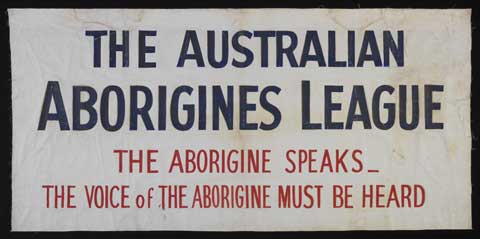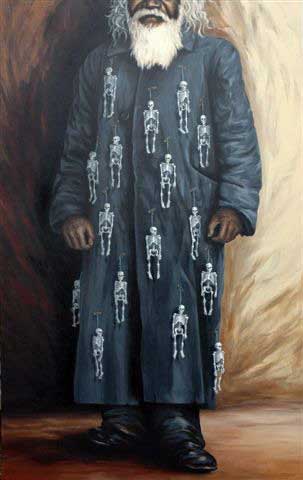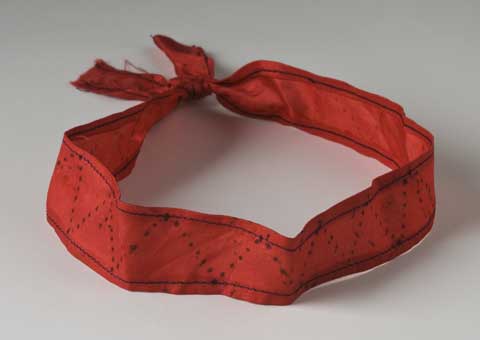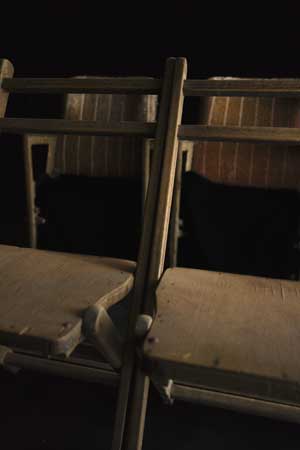Jay Arthur, National Museum of Australia, 27 March 2009
JAY ARTHUR: My name is Jay Arthur and I’m part of the Aboriginal and Torres Strait Islander Program here at the National Museum of Australia and with my colleague Karolina Kilian we are working on an exhibition on Aboriginal civil rights. Of course, everyone knows what’s going to be in that kind of exhibition [images shown], except for those of you who may have noticed the title of the exhibition and the date. The Aboriginal flag was developed in 1971. This exhibition of Aboriginal protests has no red, black or yellow. It is also before the era of silk-printed T-shirts and that kind of familiar protest material.
We did have some material in our collection. [Images shown] We just chucked that out, that out and start again. Let’s start with this item [Image shown] which is a sticker to do with the Gurindji walk-off when Aboriginal stockmen from the Vesteys Wave Hill Station walked off in protest at their employment conditions.
We also had two other extremely important protest items - we’ll talk about them later.
Let’s step back a bit. This exhibition came out of an ARC [Australian Research Council] project done by Dr Sue Taffe from Monash University and the Museum was one of the participants. It created a book entitled Black and White Together: FCAATSI, the Federal Council for the Advancement of Aborigines and Torres Strait Islanders, 1958-1973 and also fantastic website which our Museum website hosts, which I recommend to you called Collaborating for Indigenous Rights.
Working with Sue gave us not only her wonderful scholarship - what curator would want more than a scholar who has been working for ten years on the project - but also enabled us to start our targetted collecting project on this rather forgotten and unknown story with all her connections as well as her scholarship.
One of her connections led us to a rather miraculous survival. This is a banner from the 1940s.

How many protest banners survive, let alone a protest banner from the 1940s, let alone a protest banner done by famous activist Bill Onus, who is the father of the famous artist Lyn Onus? That was a curator’s miracle.
There was another one. There was an Aboriginal man who used to stand outside Australia House in London in the 1920s protesting at the condition of Aboriginal people in Australia. We want to tell his story but we had no objects, not even a photo. And then someone listening to the radio hears his story and think, 'Wow, what a story. I must paint his portrait,' and then I must donate it to a big cultural institution so they can show it.

He used to wear skeletons sewn over his coat and a sign saying, ‘This is what the Australian Government has done to my people.’
This is my third miracle object, [Petition to the Prime Minister embedded in a bark painting, from Yirrkala residents, 1963], the well-known bark petition from the people of Yirrkala protesting at mining in their country. There were actually four done, and ours is the most original and in the best condition. When I went to pick it up from the owner who lived in Lincoln Close, Chapman a couple of years ago, the houses on either side were blackened ruins. He had stood on the roof of his house and saved his house and that petition, which was wrapped in a towel in the linen cupboard.
This project has also enhanced some of our collection through loans for this exhibition. [poster shown] That’s a poster from our collection for the 1967 Referendum. In the exhibition will be the camera that took the photo [camera image shown]. We know the person who took the photo, the circumstances in which he took it and the reason he was interested in Indigenous affairs, because he was a Jewish refugee.
We will also have some little fragments of history such as this little bit of ribbon.

That meeting in 1970 was important because it was then that Aboriginal people said, ‘You’ve been running this organisation for us but not by us. We want to take part and run this organisation.’ So Aboriginal people and their supporters put on red headbands to show support for Indigenous control of organisations, and that was the beginning of the change from the fight for civil rights to the fight for Indigenous rights.
There are many takes you could put on this story of civil rights, and we’ve chosen to take the tack of looking at the individual activists who changed things so that it becomes an exhibition about agents, not victims. So we bought into the NHC [National Historical Collection] some wonderful items.
This is Joe McGinness, President of that Federal Council [image of Joe McGinness], and his wharfie’s hook [Collection highlight on Joe McGinness collection]. There was a huge diversity of people who worked for civil rights from all kinds of backgrounds, and he was a wharfie. Every wharfie had their own hook.
That’s Stan Davey, a former Christian minister [image of Stan Davey], and on that tape-recorder [image shown] he recorded thousands of hours of testimony of discrimination.
And that’s Faith Bandler and her gloves [Collection highlight on Faith Bandler's gloves], the famous worker for the 1967 Referendum. Why the gloves? Because in the fifties and sixties if you wanted to protest, you frocked up, you went to meetings and you went to see parliamentarians - no T-shirts and long hair.
This is Shirley Andrews, another activist [image of Shirley Andrews], who was not only an activist but a dancer.
Those T-shirts and badges often had slogans or statement or comments on them. Our objects are silent. How do you give them voice? What we’ve done is embedded them in the context of quotes from those activists. This is a quote from Shirley Andrews:
One of our national characteristics is that we think if we’ve talked about something we’ve done it.
Shirley Andrews 1989 [shown on slide].
A plain spoken woman, as you see. This is the famous Yorta Yorta activist William Cooper and this is his comment:
My people …how can we save them?
We talk to politicians and they say
Yes, they’ll do this and do that
but the years go on and what is done?
William Cooper August 1937 [shown on slide]
Look at the date. It’s so sad.
This is Charlie Perkins [image of Charlie Perkins] and this is one of his comments when he was on the Freedom Ride, that group of Sydney University students who travelled around New South Wales in 1965 locating instances of segregation and discrimination:
Well, there it is, I’ve made my stand
I’m saying this, for good or bad, it’s there.
What I feel is what I’ve got in front of me here.
Charles Perkins, on writing his first placard on the Freedom Ride. Walgett, NSW [shown on slide]
This is Jack Patten [image of Jack Patten], another early activist, and this is one of his comments:
You have almost exterminated our people
but there are enough of us remaining to expose the humbug of your claim, as white Australians,
to be a civilised, progressive, liberal and humane nation.
Jack Patten 1938 [shown on slide]
Of course, the 150th anniversary of British occupation.
[Image of Mary Bennett] And a quote from Mary Bennett, another plain speaker, as you’ll see:
The Aborigines were not a dying race
until white people made them die
by refusing them the most elementary human rights.
Mary Montgomerie Bennett 1957 [shown on slide]
Because these objects aren’t red, black and yellow or they’re not T-shirts or badges, they will of course be able to tell other stories in the Museum at other occasions. Shirley Andrews was one of the founders of the National Folk Festival. Raj Nagi, who painted that portrait, is a Sikh Australian. He said to me how important his Sikh religion was, and also his personal experience of racism in Australia in his decision to paint that portrait. So we have a story of an ethnic community’s relationship to Aboriginal discrimination.
Finally we come to my favourite objects in the exhibition [image shown]. The Bowra Theatre was one of the places targetted by the Freedom Ride because like most - certainly many - Australian country cinemas it was segregated with white people on the plush seats at the back and Aboriginal people on the wooden seats down the front.

This is a story of the innocence of objects - innocent but complicit - because their familiar harmless bodies act out this hidden and shameful story in our national narrative when we place them in an exhibition context. In the exhibition there will be a row of wooden chairs and there will be a row of plush chairs. So those chairs will be able to tell us the story: the story of the pervasiveness of discrimination in a country town where the swimming pool, the RSL club, the dress shop, the café and the cinema were all problematic places for Aboriginal residents of country towns. They talk about the way Aboriginal people with their bodies had to enact their own segregation by sitting on the wooden seat, not the plush seat. They tell the story of Australia as Alabama - Alabama without signage. There are no signs saying, ‘Blacks here. Whites here’ but they are the signs.
On that day in 1965 when the Freedom Ride came to Bowraville and they went to the Bowra Theatre, Mr Raymond, the owner of the Bowraville theatre said to Charles Perkins, ‘I don’t care if you’re the Prime Minister of Australia you can’t sit in a white seat.’ Thank you.
QUESTION: Jane Crenorn from the Faculty of Art and Design, Monash University. I’d like to ask regarding that exhibition, how was the discourse of the other received?
JAY ARTHUR: Could you explain that a bit more?
QUESTION: The narrative of the marginalised - by people viewing that exhibition?
JAY ARTHUR: I should have said at the beginning that Karolina and I are working on the exhibition as we speak. It opens in September here for about five months and then it will tour Australia for a couple of years, so you will be able to answer that question when you come to the exhibition.
QUESTION: Perhaps I could follow up by asking: are you presenting it as a contestation of views that you see are held now or as a way of getting people to understand what happened in the past?
JAY ARTHUR: I think the story is located in the past. I think for a lot of Indigenous people it will bring up present resonances. When I came to write the conclusion I had to ask what do I say in the conclusion? Do I say, ‘Isn’t it great? All that discrimination is gone.’ Of course not. A lot of Indigenous people looking at the stories in those quotes that I showed you have said, ‘Well, what’s changed?’ It’s quite difficult for us dealing with that situation. You want to say something changed, because some things did change - we don’t have segregated cinemas - but there are plenty of other issues in which segregation discrimination still occurs. So when I came to write the concluding panel of that exhibition it was extraordinarily difficult.
QUESTION: Thanks, Jay. It strikes me that developing the exhibition as a travelling exhibition itself has resonances with the Freedom Ride and I wonder whether that’s something that you’ve considered.
JAY ARTHUR: To be honest not really because the travelling part is organised by another section. But what I’m more conscious of is making sure that as a national museum we have representatives from around Australia. That’s what we want to make sure so that, if it goes to Western Australia they say, ‘Oh, that’s our story. We recognise that.’ I think living in Canberra you forget the state preoccupation that people go around looking for the Victorian bit or the New South Wales bit and will respond much more to those. In Canberra we get a somewhat false view of national perspectives.
QUESTION: This is just a practical question. I was wondering where is the exhibition touring to.
JAY ARTHUR: Again, that is being resolved by the exhibition section who do the touring. As soon as the tour is ready it will go up on our website, but unfortunately we don’t know about that yet.
QUESTION: This would have enormous resonance, especially in Western Australia and the Northern Territory.
JAY ARTHUR: Yes, I think even in places where you would think there wouldn’t be much resonance there is still a great deal of resonance. I was in Kempsey last year with a group of Aboriginal men. I’d gone off to the motel and they wanted to go to the RSL club and when they got to the RSL club it was ‘closed’. But as they turned away some white blokes walked in. So there we are.
PETER STANLEY: Jay, thank you very much.
Disclaimer and copyright notice
This is an edited transcript typed from an audio recording.
The National Museum of Australia cannot guarantee its complete accuracy. Some older pages on the Museum website contain images and terms now considered outdated and inappropriate. They are a reflection of the time when the material was created and do not necessarily reflect the views of the Museum.
© National Museum of Australia 2007–25. This transcript is copyright and is intended for your general use and information. You may download, display, print and reproduce it in unaltered form only for your personal, non-commercial use or for use within your organisation. Apart from any use as permitted under the Copyright Act 1968 (Cth) all other rights are reserved.
Date published: 01 January 2018